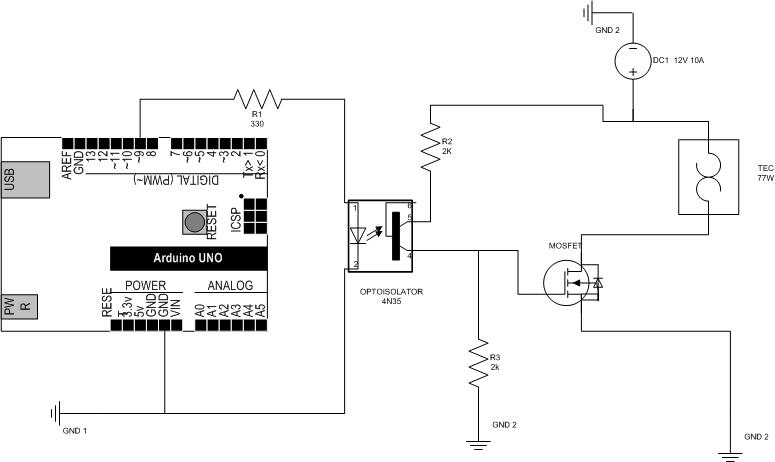I don't see any reason why your schematic wouldn't work as is. I've never used an optocoupler like yours, but here's a breakdown of what I looked at.
Is the input current safe for the optocoupler and the arduino?...
- Diode_Imax: 50mA
- Diode_Von: 1.2V
- Diode_Ion: 10mA
- Arduino_Imax: ~35mA?
- Arduino_Vpin: 5V
$$I\_diode = \frac{Arduino\_V{pin}-Diode\_V{on}}{R1}$$
$$I\_diode = \frac{5V-1.2V}{330\Omega} = 11.5mA$$
$$Diode\_Ion < I\_diode < Diode\_Imax ... Good$$
$$I\_diode < Arduino\_Imax ... (Good)$$
Is the current through the optocoupler BJT a safe value?...
$$Ice = \frac{V_{supply}}{R2+R3}$$
$$Ice = \frac{12V}{2k\Omega+2k\Omega} = 3mA$$
$$Ice < Ice_{max} ... (Good)$$
Will the voltage divider formed by R2 & R3 turn the FET ON?...
$$Vgs = V{supply} \cdot \frac{R2}{R1+R2}$$
$$Vgs = 12V*(2kohm/(2kohm+2kohm)) = 6V$$
$$Vgs > Von ... (Good)$$
Is the final output safe for the FET, peltier, and power supply?...
- Supply_Imax: 10A
- Peltier_Imax: 5.3A
- Peltier_Vmax: 14.2V
- Peltier_R: 2.4 ohms
- FET_IDmax: 22.6A
- FET_Ron: < 0.1 ohm (ignored)
$$I{supply} = \frac{V{supply}}{Peltier\_R} $$
$$I{supply} = \frac{12V}{2.4ohm} = 5A $$
$$I{supply} < Supply\_I{max} ... (Good) $$
$$I{supply} < FET\_ID{max} ... (Good) $$
$$I{supply} < Peltier\_I{max} ... (Close) $$
The current through the peltier is close to its max limit. Is that a problem? I don't know. The max rating could already be derated and there could be variation in the peltier resistance or the supply voltage. Personally, I would probably add a 1-2ohm power resistor, but that would waste power to give myself piece of mind. Another option would be to increase Ron, by decreasing R3 or using a less efficient FET.

